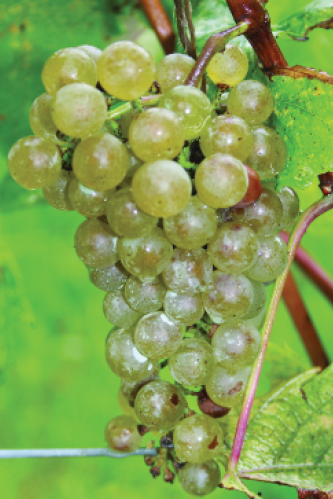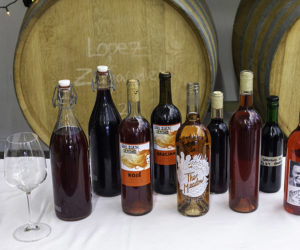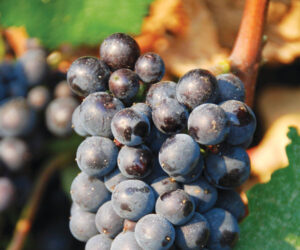 During the mid 1980s in New Zealand, when the Cloudy Bay Winery captured the attention of the world marketplace with its version of Sauvignon Blanc, a new era was born. Today, many New Zealand wineries are producing world-class Sauvignon Blanc along with other varieties.
During the mid 1980s in New Zealand, when the Cloudy Bay Winery captured the attention of the world marketplace with its version of Sauvignon Blanc, a new era was born. Today, many New Zealand wineries are producing world-class Sauvignon Blanc along with other varieties.
The Sauvignon Blanc from New Zealand is a more powerful variety than the varieties of the grape grown and made in other countries of the world. Early picking of the Sauvignon Blanc grape in New Zealand usually results in herbaceous tones of lychee fruit, newly mown grass, and asparagus. Other unusual descriptions have been used to describe the wine from this area. Sauvignon Blanc is different in New Zealand because of the soil, climate and “terroir.”
In the 1980s in the United States, Sauvignon Blanc’s popularity floundered until the progressive Robert Mondavi decided to call his Sauvignon Blanc “Fumé Blanc” in an attempt to improve sales of the wine. The success was instant and Sauvignon Blanc sales have escalated. It is now the second most popular white wine in the country (after Chardonnay) and closing the gap. At last count, there were over 22,000 acres of Sauvignon Blanc vines planted in California, up from only 7,000 acres planted just a dozen years ago.
Today, throughout the world, Sauvignon Blanc is being made and enjoyed by a wide range of admirers in a wide range of styles. From the pungent, explosive Sauvignon Blancs of New Zealand to the austere, flinty Sancerres of the Loire, Sauvignon Blanc has proven to be a popular, enjoyable table wine.
The process of making Sauvignon Blanc is a simple one. It is generally fermented in stainless steel tanks. And, in order to retain the grape’s fruitiness, it is fermented at low temperatures, which maximizes its fruit potential. A recommended fermentation temperature range is 42° to 50° F (5.6° to 10° C). After a few rackings the wine is fined, filtered and bottled within a few months of fermentation. It’s not uncommon for Sauvignon Blanc to be bottled four months after fermentation and drunk just a month or so later.
Sauvignon Blanc does not usually experience “bottle shock” like most other wines. It’s a variety which should be drunk young to capture the true acidity and fruit flavors, although many Sauvignon Blanc wines can live for years with the proper cellaring.
In the Bordeaux region of France, Sauvignon Blanc has been the featured white variety for centuries. The Sémillon grape variety is usually planted in the same regions in France as the Sauvignon Blanc and is usually blended with Sauvignon Blanc. In Bordeaux, Sauvignon Blanc is considered to be a second-choice grape and is planted in areas where the French feel that red varieties will not do well. The white table wines from Bordeaux reflect this second-class attitude and the wines are not particularly memorable. Although, with cooperation from Mother Nature, this variety makes one of the world’s great dessert wines, Sauternes. In special years, about three a decade, when the weather is ideal for its development, noble rot (Botrytis Cinerea) attacks the Sauvignon Blanc and Sémillon grapes and leaves the variety with little juice but a high concentration of sugar, acid and flavor. It is from these blighted grapes that the great and unusual dessert wine, Sauternes, is made.
Perhaps the best Sauvignon Blanc white table wines from the Bordeaux region of France include Graves and Entre-Deux-Mers. Graves is the name of the region where the wine is made in Bordeaux. The word means “gravelly” and describes the type of soil located in the region. Entre-Deux-Mers in French means “Between Two Seas;” the vineyards lie between the Garonne and Dordogne rivers east of the city of Bordeaux, hence the name.
Many say that it’s in the Loire River Valley region of France where the Sauvignon Blanc reaches its zenith of quality. The limestone and flinty soils of this region assist in making the world-renown Sancerre, Pouilly-sur-Loire and Blanc Fumé wines which reflect the soil’s “flinty” and “smoky” nature.
Across the Alps, in Northern Italy, Sauvignon Blanc does very well and some 8,000 acres are planted in Friuli, Alto Adige and Collio. The Sauvignon Blanc wines from these regions exhibit excellent fruit and varietal characteristics and are rapidly gaining international recognition.
“Sauvignon” is the leading white wine being exported out of Chile but there is some concern that it might be a different variety known as “Sauvignon Vert” whose original parentage is undetermined and the subject of much speculation. American Sauvignon Blanc clones are presently being planted and should help solve the parentage puzzle in a few years.
Another success story concerning Sauvignon Blanc comes from South Africa where over 10,000 acres of Sauvignon Blanc vineyards are growing and more are being added all of the time. The terroir of many South African regions is just right for the Sauvignon Blanc to flourish. Like many emerging premier winemaking regions of the world, South Africa has come up with some unusual wine blends. They blend Sauvignon Blanc and Chardonnay with great success. The combination of these varieties marries very well and a new taste has been developed and enjoyed.
Making Sauvignon Blanc at Home
From a winemaker’s standpoint, Sauvignon Blanc is one of the easiest wines to make. The two best wines I have ever made, in over 40 years of home winemaking, were both Sauvignon Blancs. These wines came from two different sources and were made from two different types of basic materials.
The first award-winning Sauvignon Blanc (1993) was made from frozen juice from the Dry Creek region of Sonoma, California. I purchased the five-gallon container from Presque Isle Wine Cellars in North East, Pennsylvania. The original source was the Peter Brehm Vineyards of Albany, California, which specializes in quick-frozen juices. The information on the container was accurate and no adjustments of acid or sugar had to be made. (Sugar was 22° Brix and acid was listed as 0.7). When the juice thawed (it took about three days), I tested it and inoculated it with one (5 g) package of Red Star Cotes des Blancs dry yeast (which included 2 teaspoons of yeast nutrient) and then let it go.
Fermentation was completed in ten days and I racked the wine into a clean 5-gallon carboy, added 1/2 teaspoon (3 g) of potassium metabisulfite and placed the carboy on my back cellar steps. I didn’t want a malolactic fermentation and I wanted to eliminate the tartrate crystals with this cold stabilization. After a month, I brought the wine inside and racked it again and did this three more times over the next four months.
The wine was clear and tasted fine after the fourth racking, so I gave it a light, paper filter and bottled it. It was simple and not at all time-consuming. After four months, I tasted it and it was magnificent. This wine won gold medals in the Indiana State Fair competition, The Annual American Wine Society competition and the annual Connecticut Amateur Winemakers competition. The wine had the traditional flinty, grassy, herbal characteristics and was as good as any commercial Sauvignon Blanc I had ever tasted.
The second Sauvignon Blanc beauty was made from juice I purchased from Maltose Express in Monroe, Connecticut in 1998. The juice came from California and was called Regina. After testing, I did have to adjust the acid as the tested amount was only 0.45 TA, so I brought it up to 0.7 and left the sugar alone (it was 21° Brix). I followed the same basic procedure as I had done with the frozen juice and the results were similar — an excellent, outstanding white table wine with all of the varietal characteristics of the Sauvignon Blanc. This year, I entered the wine in the Indiana State Fair competition and the wine earned a Gold Medal. In the Connecticut Amateur Home Winemakers competition, the wine won the “Best of Show Award” and the wine has been entered in the National American Wine Society’s annual competition, which, at the time of this writing, had not yet been conducted.
My wines were made in the fresh, non-malolactic fermentation process and are to be drunk young while the fruit and acids are crisp and pungent, but there are many other options to making excellent Sauvignon Blanc. The addition of oak can add complexity; vanilla and other traits and malolactic fermentation can make the wine completely different. It will have buttery flavors and subdued fruit flavors but the wine can be attractive. It comes down to style preference. Which style do you wish to make, what type of wine do you like better, what foods are you going to match the wine with and when do you want to drink the wine? These are all questions you must answer before you start. Try to develop a style, analyze it, then make changes if you are not happy with your wine.
Depending upon your equipment, your resources and the space you have, you can select from a wide range of options. First choose what type of basic materials you wish to start with: fresh grapes, frozen juice, pasteurized or sulfited juices, concentrates or kits. Any of these various selections can help you to produce an excellent Sauvignon Blanc.
Because of the increasing popularity and success of white juices, we are including a Sauvignon Blanc recipe that uses Sauvignon Blanc juice as the basic ingredient.
Sauvignon Blanc Wine Made From Juice
Yield: 5 Gallons (19L)
Ingredients
- 5 gallons (19 L) Sauvignon Blanc juice
- 1 pkg. (5 g) of Lalvin EC-1118 or Red Star Cotes Del Blancs yeast
- 3 tsp. (8.8 g) yeast nutrient
- 20 Campden tablets or 2 teaspoons (12.4 g) potassium metabisulfite powder.
Step by Step
- Sanitize all equipment.
- Through a screened funnel, pour approximately 4 gallons (15 L) of juice into a 5-gallon (19 L) carboy and the remaining gallon (3.8 L) of juice into two 1-gallon (3.8 L) jugs.
- Test for acid and sugar and make adjustments, if necessary. When the specific gravity is 1.070 to 1.092, make a yeast starter by pouring 4 ounces (120 mL) of grape juice and 4 ounces (120 mL) of lukewarm water into a bowl. Sprinkle the yeast and the yeast nutrient into the solution, allowing it to proliferate for about 30 minutes. Add 6 ounces (180 mL) of the yeast starter to the carboy and 1 ounce (30 mL) of the starter to each of the 1-gallon (3.8 L) containers. Swish to mix.
- Place a sheet of paper towel, a wad of cotton, or a paper napkin into the necks of the containers. Fermentation will start in two or three days. When the must is seen actively “bubbling,” replace the paper or cotton stoppers with air- locks, filled with clean water, for the rest of the fermentation.
- Fermentation will continue for 7 to 12 days. Start to monitor the progress with the hydrometer after 7 days. When the specific gravity is below 0.990, proceed to the next step. If it’s above 0.990, allow the wine to ferment longer.
- Once the specific gravity is below 0.990 for at least two weeks, siphon the wine from the three containers into a sanitized carboy. This procedure is called racking. Stabilize the wine by adding 5 crushed Campden tablets or 1/2 teaspoon potassium metabisulfite powder to the clean container. Then fill the container to the top. Place the wine in a cool spot (like a garage or root cellar).
- Let wine sit for 3 to 4 weeks. If it stays longer, rack it again every 3 to 4 weeks. Always add crushed Campden tablets or metabisulfite powder to each new racking to halt oxidation and bacterial infection. After the fourth racking, the wine should be clear enough to bottle.
- If the wine doesn’t clear, use gelatin or kieselsol finings. (Follow directions for procedure and quantities.) When fining, the wine will need 3 to 4 weeks to clear.
- When the wine is clear, it’s ready to bottle. Taste the wine and adjust its sweetness, if desired, then bottle. Age for three months before tasting. For an oaky flavor, add oak chips or Oak Mor to the must before fermentation, and then add more after each racking if desired. Start with three tablespoons, then go from there. Keep tasting to evaluate and stop adding when satisfied.
I have tasted some excellent Sauvignon Blanc wines that were made from concentrates. These wines are getting better and better all of the time. Since we know that some people don’t have the room or facilities to make wine from grapes or juices, concentrates are the answer. Here is a great and simple recipe for Sauvignon Blanc that is made from concentrate.
Wine Made From Sauvignon Blanc Concentrate
Yield: 5 gallons (19L)
Ingredients
- 1 can (96 oz.or 2.8 L) Sauvignon Blanc Concentrate
- 5-3/4 cans (16.3 L) water
- 5 cups (1.1 kg) sugar
- 4 tsp. (13.6 g) bentonite
- 2 tsp. (10.2 g) acid blend
- 1 package (5 g) of Lalvin EC-1118 or Red Star Cotes des Blancs yeast
- 15 Campden tablets or 1-1/2 tsp. (9.3 g) potassium metabisulfite
Step by Step
- Sanitize all equipment.
- Hydrate the bentonite for 24 hours before mixing with the other ingredients. Fully dissolve the sugar in the water before adding it to the concentrate. Put the concentrate, water, sugar, yeast nutrient, bentonite and acid blend into a clean 6- or 7-gallon (23 to 27 L) fermentation container. Stir well, so all ingredients are completely dissolved.
- Dissolve the yeast in 1 cup (240 mL) of the above mixture, then add to the fermentation container and mix well. Place in a cool (60° to 72° F (15.6° to 22.2° C) and dry location.
- Stir daily until fermentation starts, then stop.
- After 3 or 4 days, if there are no bubbles or gas (evidence of fermentation) warm the container to about 75° F (24° C) until surface bubbles appear. Continue stirring once a day. Remove to a cool location when fermentation starts.
- Fermentation is complete when bubbling stops and sediment forms on the bottom. (Refer to steps 5 and 6 from juice recipe.)
- Allow the wine to settle out 1 or 2 weeks after fermentation ends.
- Crush to a powder 5 Campden tablets or use 1/2 teaspoon (3 g) potassium metabisulfite powder and add to a sanitized 5-gallon (19 L) glass carboy before racking. Repeat at each racking.
- Rack. Siphon clear wine off the top into the 5-gallon glass carboy, being careful not to disturb the sediment. Discard sediment.
- Rack in 3 weeks and again in 3 months. The wine should be crystal clear and ready for bottling.
- Sanitize 26 750-ml bottles, fill them, and insert closures. Wait 3 months, then taste.
Editor’s Note: Readers may notice that the sulfite amounts in these recipes are a bit higher than the levels recommended in “Solving the Sulfite Puzzle” by Daniel Pambianchi. This is because author Gene Spaziani designs his recipes for students who are taught to “err on the side of caution.” According to Spaziani: “Successful commercial winemakers recommend these amounts for amateur winemakers to ensure that their wines don’t oxidize. Sulfite addition is a very individualistic practice; amounts vary depending on the variety of wine made as well as the winemaker’s personal preference. Similarly, the choice of yeast is also a matter of preference and many commercial yeasts are suitable.” Adds Pambianchi: “Keep in mind that wine recipes are not chemistry experiments in which exact quantities are crucial. Sulfite additions really depend on the winemaker and the variety of wine.”







